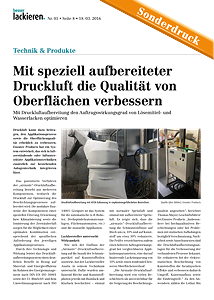The following report was published by the trade magazine “besser lackieren” on March 18, 2016. We document it verbatim.
The patented “airmatic atomization optimization” process consists of several components, whereby the compressed air is prepared to optimize the coating process. The modular design of the components of a special filtering, heating or air conditioning as well as the ionization of the atomization air ensure the possibility of an optimal combination according to the specific requirements of the respective application process.
Due to its technology and effect, the compressed air preparation system provides a clear benefit in terms of material and energy efficiency within the framework of energy management according to DIN EN ISO 50001 and the 31st BImSchV and environmental management according to ISO 14001. The system is suitable for automatic (e.g. robots, rotary spindle automatic systems, surface machines, etc.) and manual application.
The paint manufacturer Axalta has investigated in its technical center how the influence of the "airmatic atomization optimization" affects the number of dirt particles on plastic parts. For this purpose, metal sheets and plastic panels were extensively coated with base coat and clear coat - once with normal spray air and once with treated spray air. It was shown that the "airmatic atomization optimization" reduced the influence of dirt on metal sheets by around 10% and on plastic by around 30%. The testers also recorded a higher application efficiency with comparable application parameters, a paint saving of 10% based on this and a trend towards better surface finish.
"Many coaters consider the airmatic atomization optimization to be indispensable for improving coating quality," reports Thomas Mayer, Managing Director at ensutec Products. "The compressed air treatment systems are known for improving existing processes, particularly for high-quality coatings or problems with static charges related to contamination, rework and scrap rates. They reduce the Faraday effects in the electrostatic coating of plastics and thus improve the wraparound, edge structure and penetration depth."
Users include Lothar Bix GmbH from Meßkirch and a company belonging to the car manufacturer Kia/Hyundai. Bix coats decorative plastic parts for the automotive industry as well as for customers in the medical and electronics sectors and applies its paints on several lines with conventional air-atomizing pneumatics in 2- or 3-layer paint structures. This confirms the results determined in the Axalta technical center. The coater records paint savings of up to 10-15% due to increased application efficiency, significantly less overspray and flashover mist on the undersides and higher surface quality due to better flow of the clear coat. There were also fewer lean spots and edge build-up on geometrically complex structures and a reduction in rework due to less dust and dirt.
In addition to bumpers, the paint lines of the company, which belongs to the car manufacturer Kia/Hyundai, also coat plastic parts for the exterior and interior. With the "airmatic" system, the company saves around 8,121 tp3t of paint material (primer, base coat and clear coat), was able to increase the first run rate by around 8,101 tp3t by reducing the number of dirt particles, recorded a more consistent color quality and, thanks to significantly less overspray, a reduction in the amount of paint mist that spreads to other parts that have already been painted.
Experience in industrial painting practice shows that compressed air preparation reduces static charges and thus the contamination of already painted parts as well as the need for rework. The paint spreads better and achieves a more even surface finish. Heating the compressed air reduces the drying processes and thus increases the capacity of the painting system. ensutec Products now has an air conditioning system in its portfolio with which the compressed air can be made available with an accuracy of +/-1-2 °C even when the air volume is constantly changing.


